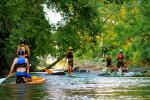Magazine
Early Appalachian settlers lived off the land, planting crops on mountainsides that were anything but flat. To ensure the family’s survival, though, folks in the mountains relied on agriculture. They knew that if you wanted to eat, you had to protect your garden. Since it took a lot of time and effort to build a garden fence, they often looked for other ways to keep hungry critters out.
Traditional Tactics
- ‹ previous
- 7 of 21
- next ›








